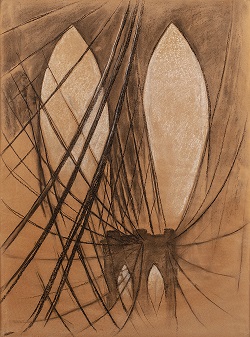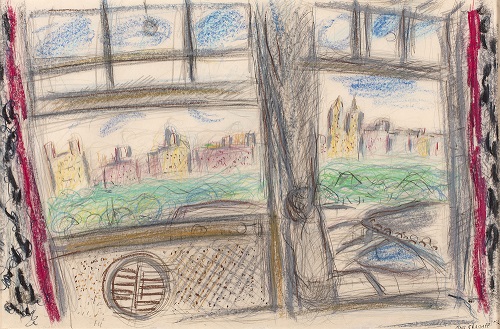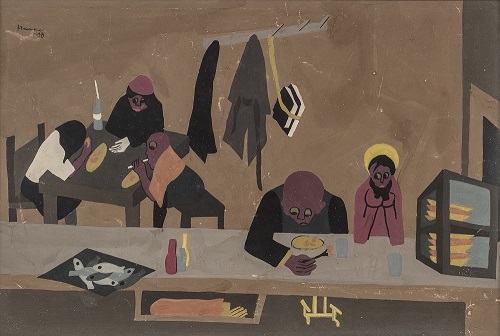 Scenes of New York City is an impressive new exhibit of paintings and other artwork including Chagall, Hockney, O’Keefe, Rockwell and Lawrence.
Scenes of New York City is an impressive new exhibit of paintings and other artwork including Chagall, Hockney, O’Keefe, Rockwell and Lawrence.
There are 130 pieces on display, opening Friday, Oct. 22 at the New York Historical Society.
Philanthropists and art collectors by Elie and Sara Hirschfeld donated this collection, and the exhibit is also named for them. In addition to paintings, the collection includes works on paper and sculptures, all celebrating such NYC landmarks as the Brooklyn Brige and Statue of Liberty, and ordinary folks doing ordinary things like dining out.
Some of the artists are new to the NYHS, including Marc Chagall, David Hockney, Edward Hopper, Jacob Lawrence, Louise Nevelson, George O’Keeffe, Norman Rockwell, and Andy Warhol.
The exhibit also includes works by William de Kooning and Peter Max.
Scenes of New York City: The Elie and Sarah Hirschfeld Collection will be on display through Feb. 27, 2022.

“Our gratitude to Elie and Sarah Hirschfeld for the generous gift of their collection is profound,” said Dr. Louise Mirrer, president and CEO of New-York Historical. “With works depicting the city’s bustling harbor, local eateries, tranquil parks, and sleek skyscrapers, our visitors will have the opportunity to see New York City with new eyes and, we hope, new appreciation.”
“Seeing the collection on display like this is a unique thrill, and one that I’m delighted to share with my fellow New Yorkers,” said Elie Hirschfeld. “Sarah and I are so pleased that New-York Historical is now the repository for Scenes of New York City and that generations to come will be able to better understand their city through these works.”
 Another exhibit currently at NYHS is Notorious RBG, about the life and impact of Brooklyn-born Ruth Bader Ginsburg, the Supreme Court Justice who passed away recently.
Another exhibit currently at NYHS is Notorious RBG, about the life and impact of Brooklyn-born Ruth Bader Ginsburg, the Supreme Court Justice who passed away recently.
This extensive exhibit features personal and historical artifacts, archival photographs and documents, contemporary art, media stations, and interactives spanning RBG’s varied roles as student, wife to Martin “Marty” Ginsburg, mother, lawyer, judge, women’s rights pioneer, and internet phenomenon.
Read more about the Notorious RBG exhibit here.
See both exhibits for one admission fee.
Purchase timed entry tickets here.
Here are descriptions of the Scenes of New York City artworks and their importance by the curators, shared with NYOTC in a press release:
Georgia O’Keeffe’s Study for “Brooklyn Bridge”, 1949, immerses the viewer amid the suspension cables and gothic arches of the celebrated bridge. Created around the time the artist left New York to live in New Mexico, the drawing may serve as her ode to the city.
Likewise, Arman’s Statue of Liberty, ca. 1986, and Peter Max’s Liberty and Justice for All, 2001, reimagine the renowned monument in New York Harbor.

Additional highlights include depictions of city life. In The Lunch Counter at S. Klein’s in Union Square in the 1930s, ca. 1930–39, Polish-born artist Theresa Bernstein depicts the racially integrated lunch counter at a popular department store. Her work often explored the major issues of her day, from racial discrimination to unemployment and suffrage—often through the lens of women’s daily lives.
Jacob Lawrence’s Harlem Diner, 1938, pictures struggle during the Great Depression and prefigures a composition from the artist’s watershed Migration Series. An early painting by Mark Rothko, Untitled (The Subway), 1937, uses the New York City subway as grounds for pictorial experimentation, presaging the abstract color fields of the artist’s mature career.
New York landscapes offer another perspective on the city. Ben Shahn’s 1930 Picnic, Prospect Park applies a modernist style inspired by Paul Cézanne and Henri Matisse to the Brooklyn greenspace.
Françoise Gilot’s Gingko Trees in Central Park, 2002-04, is a vision of autumnal yellows, while Marc Chagall’s View of Central Park from the Window, 1958 opens from the Stanhope Hotel on Fifth Avenue onto a summer scene of the famous urban grounds and Central Park West skyline.
Also included are works from movements specifically associated with New York City, such as the Ashcan School, Abstract Expressionism, and Pop Art. In Central Park, 1902, Robert Henri, founder of the Ashcan School, rejects the park’s famous landmarks to portray instead a nondescript slope, rendered in slashing brushwork and a stark urban realist style. In Untitled (New York Times), ca. 1976, Abstract
Expressionist William de Kooning breaks the strict format of the iconic newspaper with exuberant gestural strokes. And in Radiant Baby with AIDS Alligator, ca. 1984, Pop artist Keith Haring suggests a primal chase between life and death. His graffiti, applied to a Bowery subway sign, exemplifies the way he used his publicly accessible art to advance awareness of the AIDS epidemic.
Accompanying many of the works on display is commentary from a variety of New Yorkers sharing their memories and impressions of the places depicted. Local residents, writers, artists, hotel staff, baseball fans, professors, and tree enthusiasts all reflect on the ever-evolving nature of the city and its landmarks.
A Stuyvesant High School student describes the view of the city skyline from her school, for example, while a New York Public Library librarian recounts being welcomed to work each day by the building’s famous sculpted lions, Patience and Fortitude.
Exhibition Catalogue
An exhibition catalogue, edited by Roberta J.M. Olson, featuring 200 color illustrations, will be available for purchase from the NYHistory Store beginning in December 2021.
On Monday, November 1, exhibition curator Wendy Ikemoto will lead a special tour of Scenes of New York City, highlighting the new artists to join New-York Historical’s collection.
About New-York Historical Society
This is New York City’s oldest museum, founded in 1804.
The Patricia D. Klingenstein Library—one of the most distinguished in the nation—fosters research through its outstanding collections, which include more than 10 million items. The Museum presents groundbreaking history and art exhibitions as well as public programs that convey the stories of New York and the nation’s diverse populations to the broadest possible public.
The New-York Historical Society is located at 170 Central Park West at Richard Gilder Way (77th Street), New York, NY 10024. Information: (212) 873-3400. Website: nyhistory.org.
Scenes of New York City artworks shown here - by O’Keefe, Chagall and Lawrence - courtesy New York Historical Society

What do you think about this? We welcome your comments.